Li S.Z., Jain A.K. (eds.) Encyclopedia of Biometrics
Подождите немного. Документ загружается.


In contrast to LDA, the decision boundaries of QDA
are quadrat ic, which is resulted from the assump-
tion on the different covariance matrices. From the
added flexibility obtained from the quadratic decision
boundaries, QDA often outperforms LDA when the
size of training data is ver y large. However, when
the size of the training set D is small compared to the
dimension D of the feature space, the large number of
parameters of QDA relative to LDA causes over-fitting
or ill-posed estimation for the estimated covariance
matrices. To solve this problem, various regularization
or Bayesian techniques have been proposed to obtain
more robust estimates:
1. Regularized discriminant analysis (RDA) [7, 8]
employs the regularized form of covariance matri-
ces by shrinking S
k
of QDA towards the common
covariance matrix S of LDA, that is, S
k
(a) ¼ aS
k
þ
(1a)S for a 2 [0, 1]. Additionally, the common
covariance matrix S could be shrunk towards
the scalar covariance, S(g) ¼ gSþ(1g)s
2
I for g
2[0, 1]. The pair of parameters is selected by cross-
validation based on the classification accuracy of
the training set.
2. Leave-one-out covariance estimator (LOOC) [9]
finds an optimal regularized covariance matrices
by mixing four different covariance matrices of
S
k
,diag(S
k
), S, and diag(S), where the mixing
coefficients are determined by maximizing the
average leave-one-out log likelihood of each class.
3. Bayesian QDA introduces prior distributions over
the mean m
k
and the covariance matrices S
k
[10], or
over the Gaussian distributions themselves [11].
The expectations of the class-conditional densities
are calculated analytically in terms of the para-
meters. The hyper-parameters of the prior distribu-
tions are chosen by cross-validation.
Naive Bayes Classifier
In the naive Bayes classifier, the conditional indepen-
dence assumption makes the factorized class-condi-
tional densities of the form
pðxjC
k
Þ¼
Y
D
i¼1
pðx
i
jC
k
Þ: ð8Þ
The compone nt densities pðx
i
jC
k
Þ can be modeled
with various parametric and nonparametric distribu-
tions, including the following:
1. For continuous features, the component densities
are chosen to be Gaussian. In this case, the naive
Bayes classifier is equivalent to QDA with diagonal
covariance matrices for each class.
2. For discrete features, multinomial distributions are
used to model the component densities. The mul-
tinomial assumption makes a
k
(x) and the resulting
decision boundaries to be linear in x.
3. The component densities can be estimated using
one-dimensional kernel density or histogram esti-
mates for non-parametric approaches.
The naive Bayes model assumption is useful when the
dimensionality D of the feature space is very high,
making the direct density estimation in the full feature
space unreliable. It is also attractive if the feature vector
consists of heterogeneous features including continu-
ous and discrete features.
Nonparametric Approaches
One major problem of parametric approaches is that
the actual class-conditional density is not a linear nor a
quadratic form in many real-world data. It causes the
poor classification performance, since the actual distri-
bution of data is different from a functional form we
specified, regardless of parameters.
To solve this problem, one can increase the flexibility
of the density model by adding more and more para-
meters, leading to a model with infinitely man y num-
ber of parameters, called nonparametric density
estimation. Otherwise, rather than modeling the
whole distribution of a class, one can model only a
decision boundary that separates one class from the
others, since restricting the func tional form of the
boundary is a weaker assumption than restricting
that of the whole distribution of data. Either using a
nonparametric density model or modeling a decision
boundary are called nonparametric approaches. In this
article, the latter approach is only considered.
We define a function a
k
(x) as a relevancy score of
x for C
k
, such that a
k
(x) > 0ifx is more likely to be
assigned to C
k
, and a
k
(x) < 0 otherwise. Then, the
surface a
k
(x) ¼ 0 represents the decision boundary
1300
S
Supervised Learning
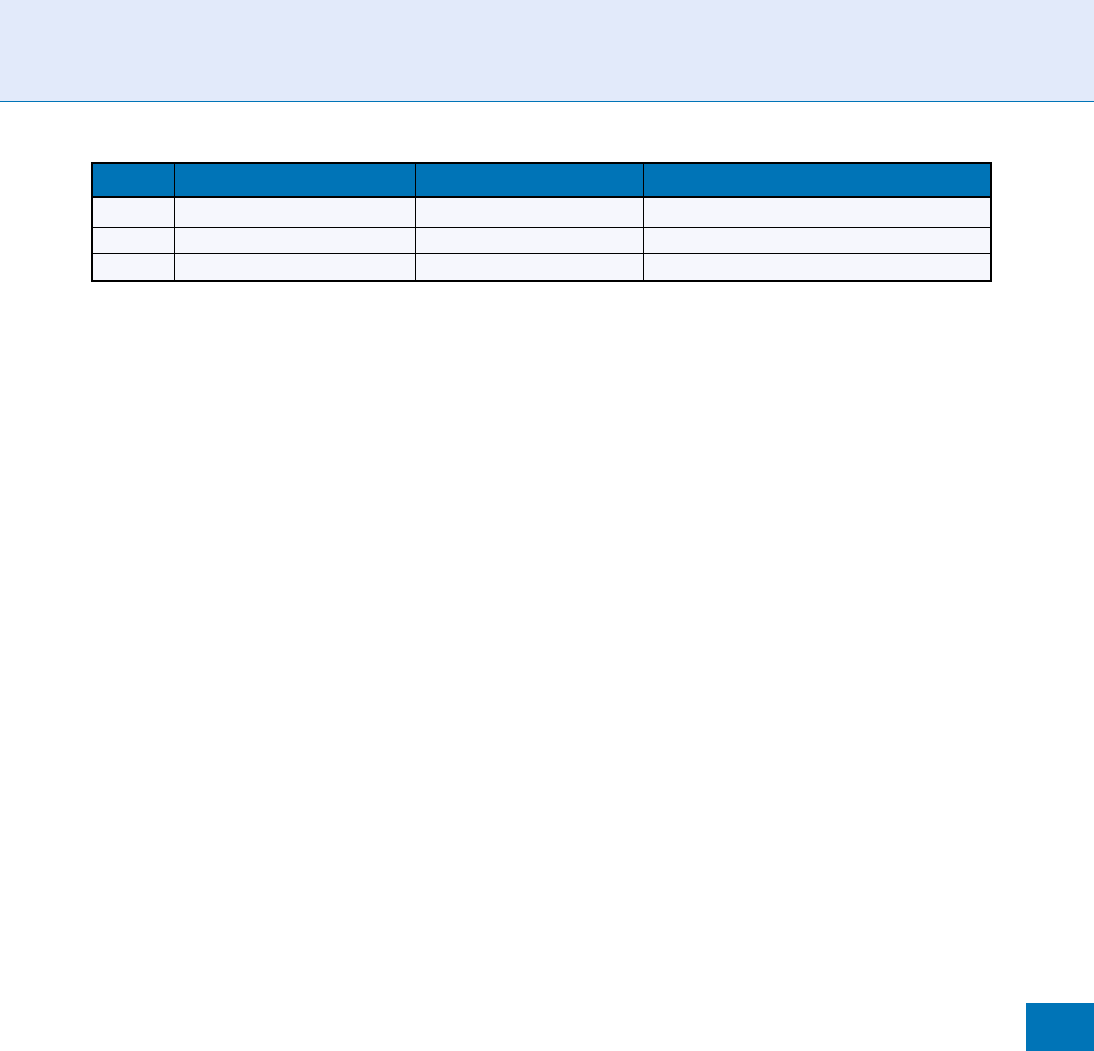
between C
k
and the other classes, and a test point x is
assigned to C
k
if k ¼ arg max
k
a
k
(x), which is called
one-against-all.
Many nonparametric methods have been derived
from various models for a
k
(x). We introduce three
representative methods [12, 13, 14] (see Table 2):
1. k-nearest neighbor algorithm (k-NN) chooses k
data points in the training set, which are closest
from x, then a
k
(x) is the number of those selected
points belonging to C
k
.
2. Artificial neural networks (ANNs) represent a
k
(x)
as a multilayered feed-forward network. The ℓth
layer consists of W
ℓ
nodes, where the jth node in
the layer sends a (non)linear function value f
j
(ℓ)
(x)
as a signal to the nodes in the (L þ 1)th layer. Then,
a
k
(x) is the signal of the kth node in the final layer,
f
k
(Lþ1)
(x).
3. Support vector machines (SVMs ) choose some
‘‘important’’ training points, called support vectors,
then represent a
k
(x) as a linear combination of
them. SVM is known to be the best supervised
learning method for most real-world data.
k-Nearest Neighbor Algorithm
Given a set of data points X ¼ {x
1
,x
2
, ...x
N
} and a set
of the corresponding labels Y ¼ {y
1
, y
2
, y
N
}, K-NN
assigns a label for a test data point x by majority voting,
that is to choose the most frequently occurred label
in {y
(1)
, y
(2)
, ...y
(k)
}, where x
(i)
denotes the ith nearest
point of x in X and y
(i)
is the label of x
(i)
. That is,
we have
a
k
ðxÞ¼jfx
ðiÞ
2C
k
gj; ð9Þ
where jj denotes the number of elements in a set. The
decision bound ary is not restricted to a specific func-
tional form. It depends only on the local distribution
of neighbors and the choice of k. Larger k makes the
decision boundary more smooth.
k-NN is widely used in biometrics, especially for
computer vision applications such as face recogni-
tion and pose estimation, where both the number of
images N and dimension of data D are quite large.
However, traditional k-NN takes O(ND) time to com-
pute distances between a test point x and all training
points x
1
, ...,x
N
, which is too inefficient for practical
use. Thus, extensive research has focused on fast
approximations based on hashing, embedding or
something [15].
Artificial Neural Networks
In ANNs, the signal of the jth node in the (ℓ þ1)th
layer is determined by the signals from the ℓth layer:
f
ð‘þ1Þ
j
ðxÞ¼g w
ð‘Þ>
j
f
ð‘Þ
ðxÞþw
ð‘Þ
j0
; ð10Þ
where w
‘
j
¼½w
ð‘Þ
j1
; w
ð‘Þ
j2
; ; w
ð‘Þ
jW
‘
>
and f
ð‘Þ
ðxÞ¼
½f
ð‘Þ
1
ðxÞ; f
ð‘Þ
2
ðxÞ; ; f
ð‘Þ
W
‘
ðxÞ
>
. The input layer,
f
(0)
(x), is simply x. g() is a nonlinear, nondecreasing
mapping, causing ANNs to yield a nonlinear decision
boundary. There are two popular mappings: (1) sig-
moid, g(x) ¼1 ∕(1þexp{x}); (2) hyperbolic tangent,
g(x) ¼ tanh(x).
More nodes and layers increase the nonlinearity of
decision boundary obtained by ANNs. However, it is
difficult to train ANNs having a number of nodes and
layers, since the model can easily fall into poor solu-
tions, called local minima.
Radial basis function (RBF) networks [16] are
another type of ANNs, having the form
a
k
ðxÞ¼w
>
k
FðxÞþw
k0
: ð11Þ
That is, RBF networks contain only one hidden layer,
denoting by F(x)¼[f
1
(x),f
2
(x),...,f
W
(x)], and the
network output is simply a linear combination of the
hidden nodes. The main difference between RBF net-
works and ANNs with L ¼ 1 is the map ping from the
Supervised Learning. Table 2 Comparison among non-parametric methods for classification
Method a
k
(x)
Number of parameters Decision boundary
k-NN jfx
ði Þ
2C
k
gj k Nonlinear
ANNs f
k
(Lþ1)
(x)
P
L
‘¼0
ðW
‘
þ 1ÞW
‘
þ 1 Linear (L¼0) or nonlinear (L>0)
SVMs
P
a
ki
>0
a
ki
y
ki
kðx
i
; xÞ O(KN) Linear (k(x
i
,x)¼x
i
T
x) or nonlinear (otherwise)
Supervised Learning
S
1301
S
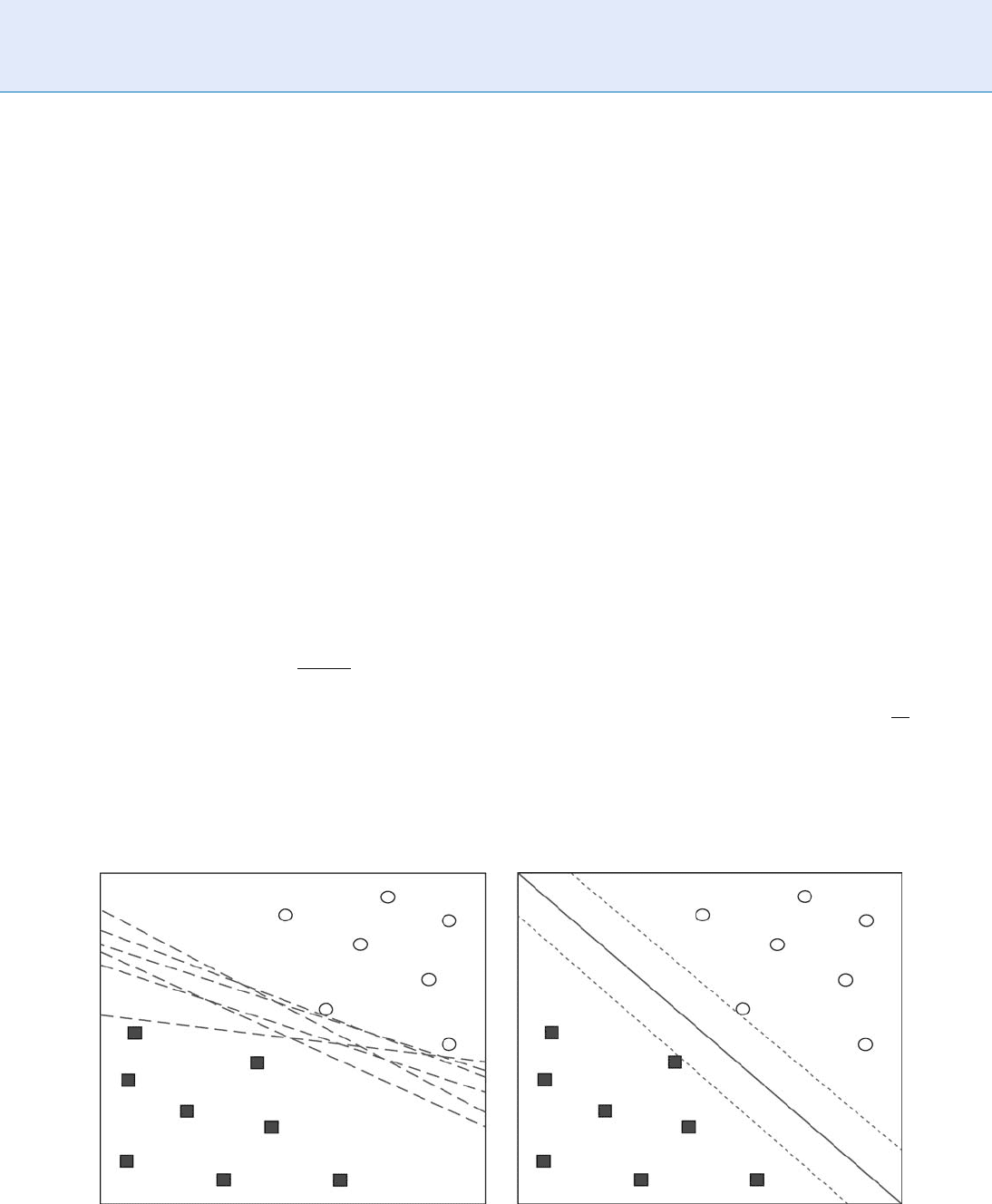
input to the hidden. In RBF networks, each j
j
()isa
nonlinear function similar to Gaussian density:
f
j
ðxÞ¼exp b
j
jjx c
j
jj
2
no
; ð12Þ
for some b
j
> 0 and the center vector c
j
. That is, each
hidden node represents local region whose center is c
j
,
and its signal would be stronger if x and c
j
are closer. In
general, c
j
is fixed to one of the training points and b
j
is
chosen by hand, thus the global optimum of w
k
and
w
k0
can be simply found by least squares fitting.
Support Vector Machines
Similar to RBF networks, SVMs obtain a linear decision
boundary in a transformed space: a
k
(x)¼w
k
T
F(x)þ
w
k0
, where F ( ) is an arbitrary mapping, either linear
or nonlinear. The difference betwen SVMs and ANNs
is the optimality of the decision boundary. In SVMs,
the optimal decision boundary is such that the distance
between the bound ary and the closest point from that
boundary, called the margin, is maximized:
max
w
k
;w
k0
min
i
ja
k
ðx
i
Þj
jjw
k
jj
: ð13Þ
This optimization problem always converges to the glob-
al solution, the maximum margin boundary. Figure 1
shows the motivation for SVMs intuitively. One can
expect that the generalization error of the maximum
margin boundary is less than that of other boundaries.
Theoretically, the generalization power of SVMs is
guaranteed by Vapnik–Chervonenkis theory [17].
Training SVMs can be rewritten as the following
convex optimi zation problem
min
w
k
;w
k0
jjw
k
jj; subject to y
ki
a
k
ðx
i
Þ1 for all i;
ð14Þ
where y
ki
¼ 1ifx
i
2C
k
and otherwise1. At the
optimum, a
k
(x) has the form
a
k
ðxÞ¼
X
n
i¼1
a
ki
y
ki
Fðx
i
Þ
>
FðxÞ; ð15Þ
where a
ki
0 is a Lagrangian multiplier of the ith
constraint, y
ki
a
k
(x
i
) 1. If a data point x
i
is exactly
on the margin, i.e., y
ki
a
k
(x
i
) ¼ 1, then x
i
is called
support vector and a
ki
> 0. Otherwise, a
ki
¼ 0 and
y
ki
a
k
(x
i
) > 1. Hence, a
k
(x) only depends on the sup-
port vectors. To compute F(x
i
)
T
F(x), we can intro-
duce a function of the form k(x
i
, x), representing the
inner product in the feature space can be used, without
computing the mapping F() explicitly. Such a func-
tion is called kernel function [18]. There are two popu-
lar kernel functions: (1) polynomial kernel, k(x
i
, x)¼
(x
i
T
xþc)
p
for some c and p > 0; (2) Gaussian kernel
(also called as RBF kernel), kðx
i
; xÞ¼expf
1
2s
2
jjx
i
xjj
2
g for some s > 0.
Various algorithms and implementations have been
developed to train SVMs efficiently. Two most popular
softwares are LIBSVM [19] and SVM
light
[20], both
Supervised Learning. Figure 1 (Left) Possible solutions obtained by neural networks. (Right) SVMs give one global
solution, the maximum margin boundary.
1302
S
Supervised Learning

implement several techniques such as working set se-
lection, shrinking heuristics, and LRU caching to speed
up optimization, and provide various kernel functions
with choosing appropriate parameters of those func-
tions automatically (automatic model selection). Two
recent extensions of SVM
light
– SVM
struct
for structured
data, SVM
perf
for training with more than hundred-
thousands of data points – are also popular in
biometrics.
Related Entries
▶ Classifier Design
▶ Machine-Learning
▶ Probability Distribution
References
1. Jain, A.K., Ross, A., Prabhakar, S.: An introduction to biometric
recognition. IEEE Trans. Circuits Syst. Video Technol. 14(1),
4–20 (2004)
2. Jain, A.K., Duin, R.P.W., Mao, J.: Statistical pattern recognition:
A review. IEEE Trans. Pattern Anal. Mach. Intell. 22(1), 4–37
(2000)
3. Duda, R.O., Hart, P.E., Stork, D.G.: Pattern Classification. Wiley,
New York (2001)
4. Bishop, C.M.: Pattern Recognition and Machine Learning.
Springer, New York (2006)
5. Hastie, T., Tibsjirani, R., Friedman, J.: The Elements of Statistical
Learning. Springer, New York (2001)
6. Hastie, T., Tibshirani, R.: Discriminant analysis by Gaussian
mixtures. J. R. Stat. Soc. Ser. B 58, 158–176 (1996)
7. Friedman, J.H.: Regularized discriminant analysis. J. Am. Stat.
Assoc. 84, 165–175 (1989)
8. Ye, J., Wang, T.: Regularized discriminant analysis for high
dimensional, low sample size data. In: Proceedings of the ACM
SIGKDD International Conference on Knowledge Discovery and
Data Mining. Philadelphia, PA (2006)
9. Hoffbeck, J.P., Landgrebe, D.A.: Covariance matrix estimation
and classification with limited training data. IEEE Trans. Pattern
Anal. Mach. Intell. 18(7), 763–767 (1996)
10. Geisser, S.: Predictive Inference: An Introduction. Chapman &
Hall, New York (1993)
11. Srivastava, S., Gupta, M.R., Frigyik, B.A.: Bayesian quadratic
discriminant analysis. J. Mach. Learn. Res. 8, 1277–1305 (2007)
12. Cover, T., Hart, P.: Nearest neighbor pattern classification. IEEE
Trans. Inf. Theory IT–13, 21–27 (1967)
13. Rumelhart, D.E., Hinton, G.E., Williams, R.J.: Learning internal
representations by backpropagating errors. Nature 323, 533–536
(1986)
14. Boser, B.E., Guyon, I., Vapnik, V.N.: A training algorithm for
optimal margin classifiers. In: Proceedings of the Fifth Annual
Workshop of Computational Learning Theory, pp. 144–152 (1992)
15. Shakhnarovich, G., Darrell, T., Indyk, P.: Nearest-Neighbor
Methods in Learning and Vision: Theory and Practice. MIT
Press, Cambridge, MA (2006)
16. Moody, J., Darken, C.J.: Fast learning in networks of locally
tuned processing units. Neural Comput. 1, 281–294 (1989)
17. Vapnik, V.N.: The Nature of Statistical Learning Theory.
Springer-Verlag, New York (1995)
18. Scho
¨
lkopf, B., Smola, A.J.: Learning with Kernels. MIT Press,
Cambridge, MA (2002)
19. Chang, C.C., Lin, C.J.: LIBSVM – A Library for Support
Vector Machines, http://www.csie.ntu.edu.tw/~cjlin/libsvm
(2000)
20. Joachims, T.: SVM
light
, http://svmlight.joachims.org (2004)
Supervisor
A generic term for a method or a system that is able to
output an aggregated opinion.
▶ Multiple Experts
Supervisor Opinion
The output of the supervisor which can be a strict score
(0 or 1) or a graded score (2 [0, 1]) representing the
belief of the supervisor on an identit y claim by aggre-
gating expert opinions.
▶ Multiple Experts
Support Vector Machine
MATHIAS M. A DANKO N,MOHAMED CHERIET
University of Quebec ETS, Montreal, Canada
Synonyms
SVM; Margin classifier; Maximum margin classifier ;
Optimal hyperplane
Support Vector Machine
S
1303
S
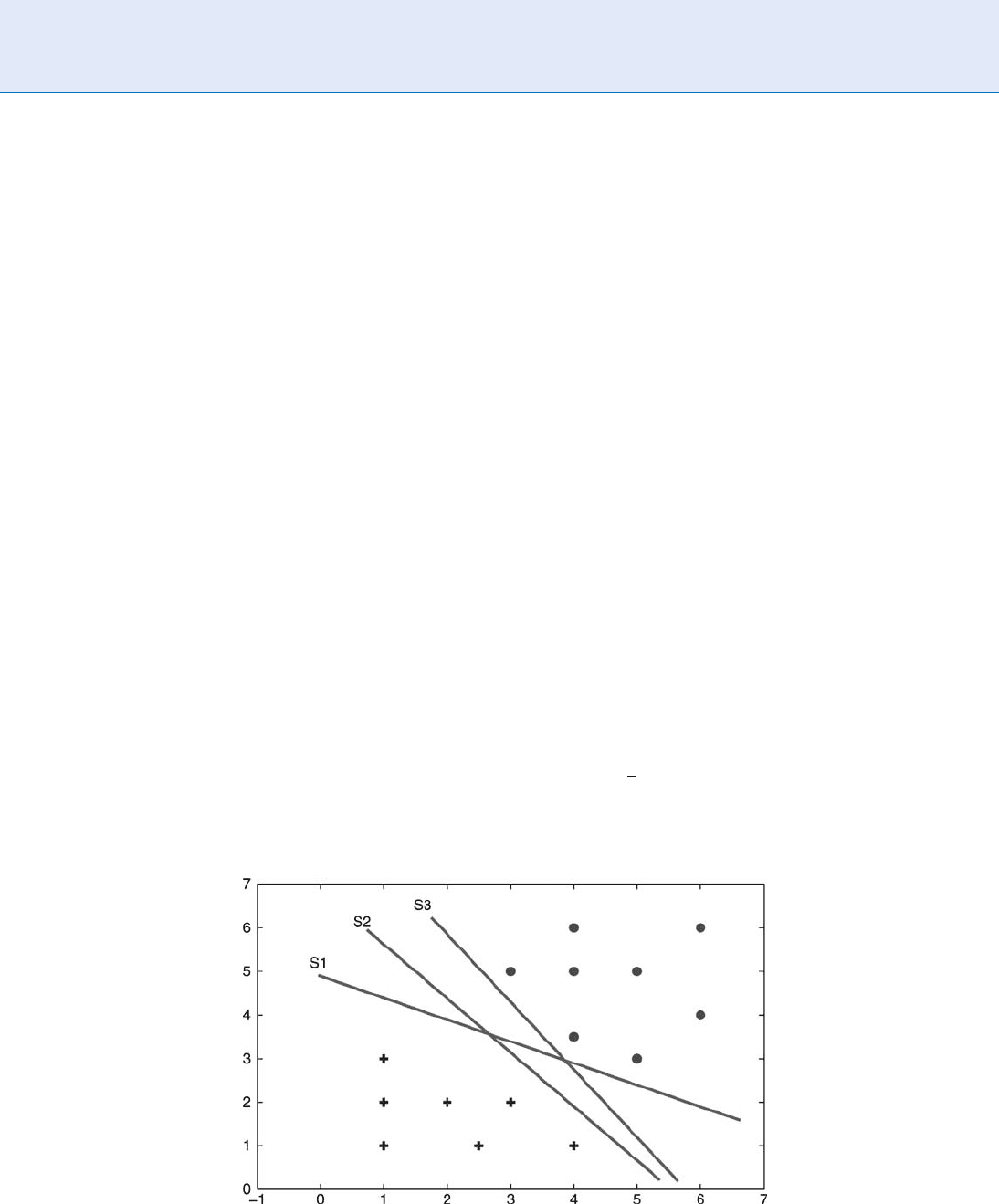
Definition
Support vector machines (SVMs) are particular linear
▶ classifiers which are based on the margin maximiza-
tion principle. They perform
▶ structural risk minimi-
zation, which improves the complexity of the classifier
with the aim of achieving excellent
▶ generalization
performance. The SVM accomplishes the classification
task by constructing, in a higher dimensional space, the
hyperplane that optimally separates the data into two
categories.
Introduction
Considering a two-category classification problem,
a linear classifier separates the space, with a hyper-
plane, into two regions, each of which is also called a
class. Before the creation of SVMs, the popular algo-
rithm for determining the parameters of a linear clas-
sifier was a single-neuron perceptron. The perceptron
algorithm uses an updating rule to generate a separat-
ing surface for a two-class problem. The procedure
is guaranteed to converge when the
▶ training data
are linearly separable, however there exists an infinite
number of hyperplanes that correctly classify these data
(see Fig. 1).
The idea behind the SVM is to select the hyper-
plane that provides the best generalization capa-
city. Then, the SVM algorithm attempts to find the
maximum margin between the two data categories
and then determines the hyperplane that is in mid-
dle of the maximum margin. Thus, the points near-
est the decision boundary are located at the same
distance from the optimal hyperplane. In machine
learning theory, it is demonstrated that the margin
maximization principle provides the SVM with a
good generalization capacity, because it minimizes
the structural risk related to the complexity of the
SVM [1].
SVM Formulation
Let consider a dataset fðx
1
; y
1
Þ; ...; ðx
‘
; y
‘
Þg with
x
i
2R
d
and y
i
2{1,1}. SVM training attempts to
find the parameters w and b of the linear decision
function f(x) ¼ w.x þ b defining the optimal hyper-
plane. The points near the decision boundary define
the margin. Considering two points x
1
, x
2
on opposite
sides of the margin with f(x
1
)¼1 and f(x
2
)¼1, the
margin equals ½f ðx
1
Þf ðx
2
Þ= w
kk
¼ 2= w
kk
. Thus,
maximizing the margin is equivalent to minimizing
||w||∕2or||w||
2
∕2. Then, to find the optimal hyper-
plane, the SVM solves the following optimization
problem:
min
w;b
1
2
w
0
w
s:t y
i
w
0
:x
i
þ bðÞ1 8i ¼ 1; ...;‘
ð1Þ
Support Vector Machine. Figure 1 Linear classifier: In this case, there exists an infinite number of solutions. Which is
the best?
1304
S
Support Vector Machine
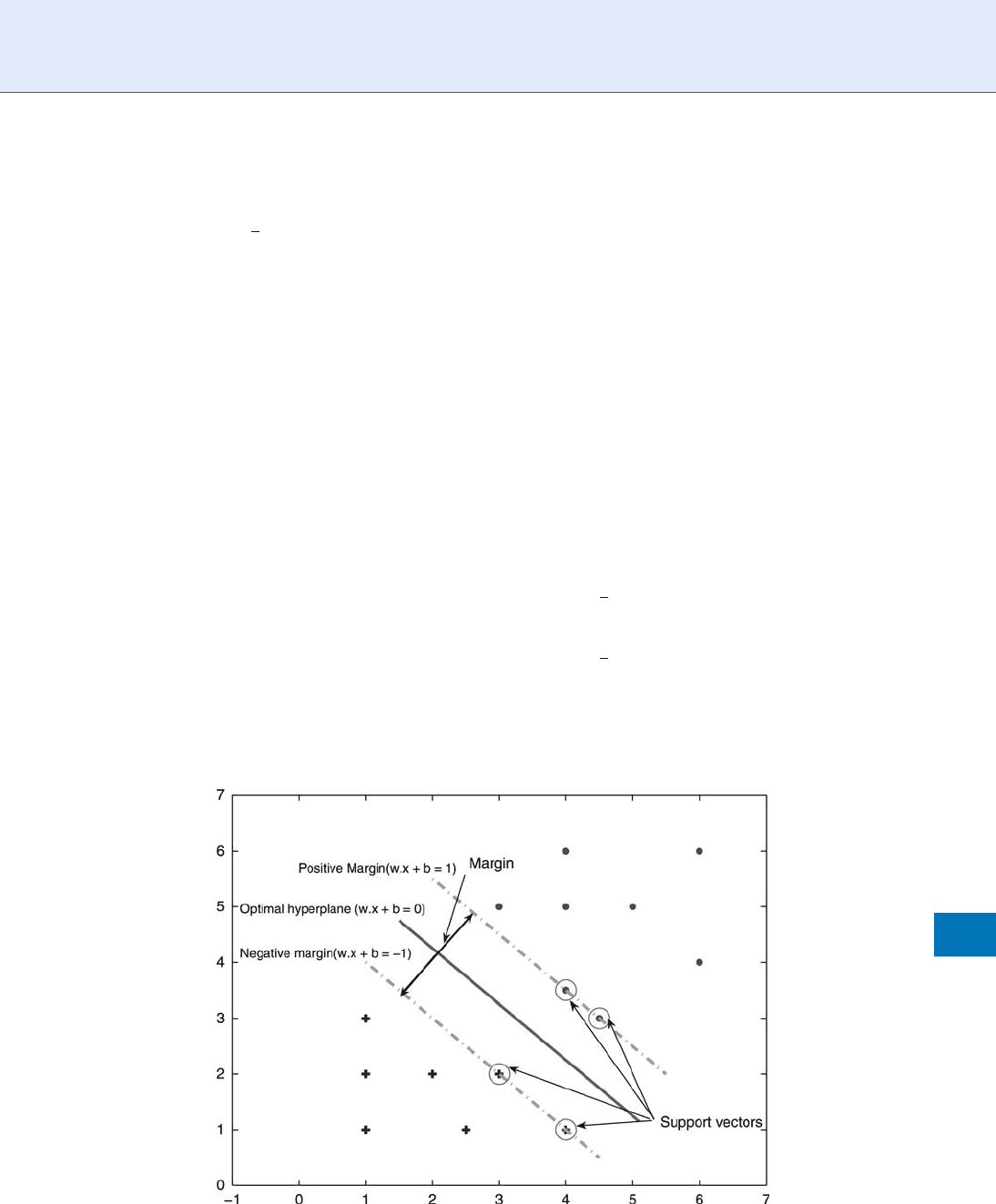
The transformation of this optimization problem
into its corresponding dual problem gives the follow-
ing quadratic problem:
max
/
X
‘
i¼1
a
i
1
2
X
‘
i;j¼1
a
i
a
j
y
i
y
i
x
i
:x
j
s:t
X
‘
i¼1
y
i
a
i
¼ 0; a 0 8i ¼ 1; ...;‘
ð2Þ
Where W
0
denotes the transpose of W.
The solution of the previous problem gives
the parameter w ¼
P
‘
i¼1
y
i
a
i
x
i
of the optimal
hyperplane. Thus, the decision function becomes
f ðxÞ¼
P
‘
i¼1
a
i
y
i
ðx
i
:xÞþb in dual space. Note that the
value of the bias b does not appear in the dual problem.
U sing the constraints of the primal problem, the bias
is given by b ¼1=2½max
y¼1
ðw:x
i
Þþmin
y¼1
ðw:x
i
Þ.
It is demonstrated with the Karush-Kuhn-Tucker
conditions that only the examples x
i
that satisfy
y
i
(w. x
i
þb)¼1 are the corresponding a
i
non-zero.
These examples are called support vectors (see Fig . 2).
SVM in Practice
In real-world problems, the data are not linearly sepa-
rable, and so a more sophisticated SVM is used to solve
them. First, the slack variable is introduced in order to
relax the margin (this is called a soft margin optimiza-
tion). Second, the kernel trick is used to produce
nonlinear boundaries [2]. The idea behind kernels is
to map training data nonlinearly into a higher-dimen-
sional feature space via a mapping function F and to
construct a separating hyperplane whi ch maximizes
the margin (see Fig. 3). The construction of the line ar
decision surf ace in this feature space only requires the
evaluation of dot products f (x
i
).f(x
j
)¼k(x
i
,x
j
), where
the application k : R
d
R
d
!Ris called the kernel
function [3, 4].
The decision function given by an SVM is:
yðxÞ¼sign½w
0
fðxÞþb; ð3Þ
where w and b are found by resolving the following
optimization problem that expresses the maximiza-
tion of the margin 2∕||w|| and the minimization of
training error:
min
w;b;x
1
2
w
0
w þ C
X
‘
i¼1
x
i
L1 SVMðÞor
min
w;b;x
1
2
w
0
w þ C
X
‘
i¼1
x
2
i
L2 SVMðÞ
ð4Þ
subject to : y
i
w
0
f x
i
ðÞ
þ b
½
1 x
i
8i ¼ 1; ...;‘
ð5Þ
Support Vector Machine. Figure 2 SVM principle: illustration of the unique and optimal hyperplane in a
two-dimensional input space based on margin maximization.
Support Vector Machine
S
1305
S
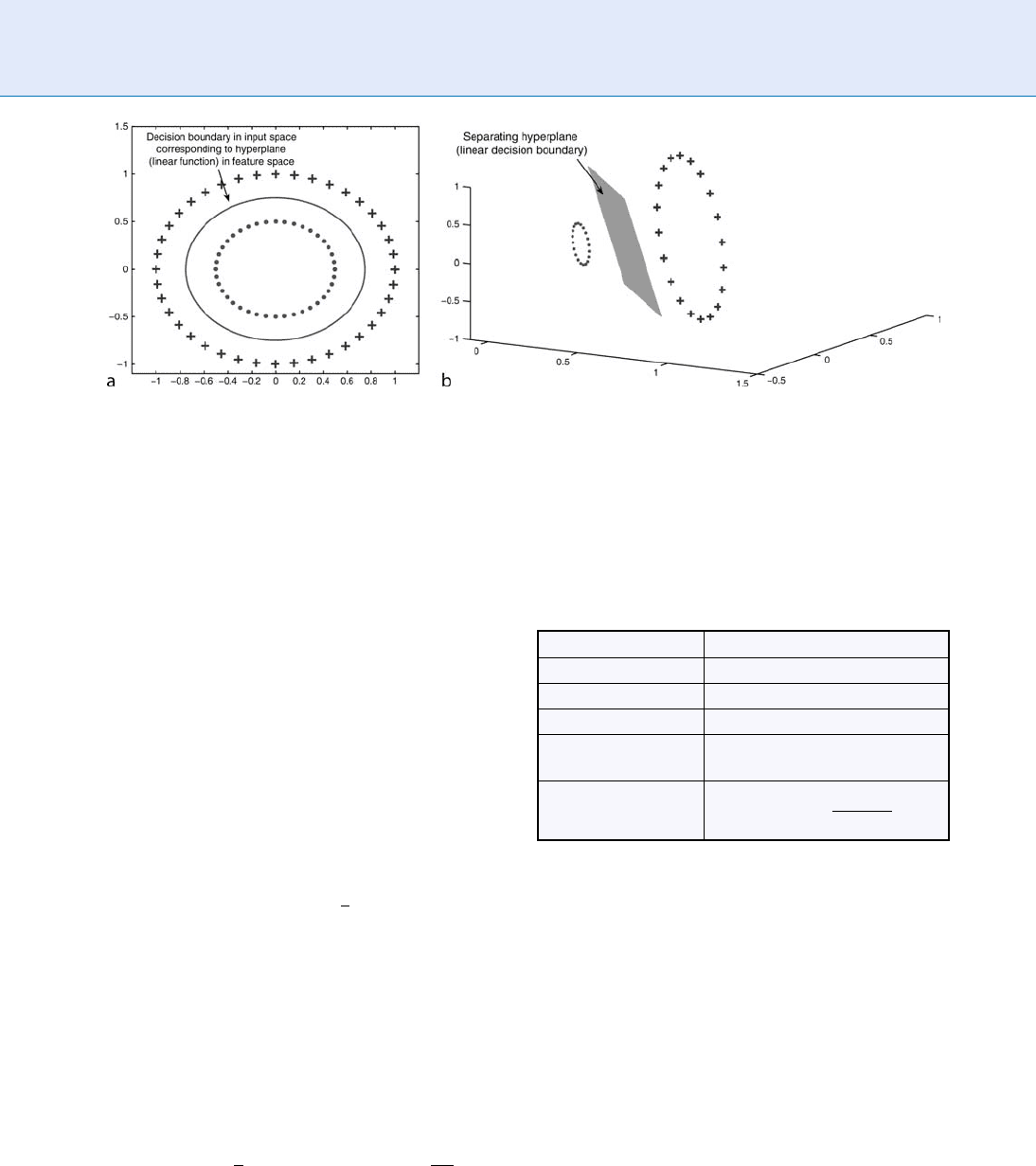
x
i
0 8i ¼ 1; ...;‘: ð6Þ
By applying the Lagrangian diffe rentiatio n theorem
to the corresponding dual problem, the followi ng
decision function is obtained:
yðxÞ¼sign½
X
i¼1
‘
a
i
y
i
kðx
i
; xÞþb; ð7Þ
with a solution of the dual problem.
The dual problem for the L1-SVM is the following
quadratic optimization problem:
maximize : W aðÞ¼
X
‘
i¼1
a
i
1
2
X
‘
i;j¼1
a
i
a
j
y
i
y
j
kx
i
; x
j
ð8Þ
subject to :
X
‘
i¼1
a
i
y
i
¼0 and 0 a
i
C;i ¼1;...;‘: ð9Þ
Using the L2-SVM, the dual problem becomes :
maximize : W aðÞ¼
X
‘
i¼1
a
i
1
2
X
‘
i:j¼1
a
i
a
j
y
i
y
j
kx
i
; x
j
þ
1
2C
d
ij
ð10Þ
subject to :
X
‘
i¼1
a
i
y
i
¼ 0 and 0 a
i
; i ¼ 1; ...‘: ð11Þ
where d
ij
¼ 1ifi ¼ j and 0 otherwise.
In practice, the L1-SVM is used most of the
time, and its popular implementation developed by
Joachims [ 5] is very fast and scales to large datasets.
This implementation, called SVMlig ht, is available
at svmlight.joachims.org.
SVM Model Selection
To achieve good SVM performance, optimum values
for the kernel parameters and for the hyperparameter C
much be chosen. The latter is a regularization parameter
controlling the trade-off between the training error min-
imization and the margin maximization. The kernel
parameters define the kernel function used to map data
into a higher-dimensional feature space (see Table 1).
Like kernel functions, there are the Gaussian kernel
k(x
i
,x
j
)¼exp(||x
i
x
j
||
2
∕s
2
) with parameter s and
Support Vector Machine. Figure 3 Illustration of the kernel trick: The data are mapped into a higher-dimensional
feature space, where a separating hyperplane is constructed using the margin maximization principle. The hyperplane
is computed using the kernel function without the explicit expression of the mapping function. (a) Nonlinearly separable
data in the input space. (b) Data in the higher-dimensional feature space.
Support Vector Machine. Table 1 Common kernel used
with SVM
Gaussian (RBF) kðx; yÞ¼expðjjx yjj
2
=s
2
Þ
Polynomial kðx; yÞ¼ðax:y þ bÞ
n
Laplacian ðx; yÞ¼expðajjx yjj þ bÞ
Multi-quadratic kðx; yÞ¼ðajjx yjjþ bÞ
1=2
Inverse multi-
quadratic
kðx; yÞ¼ðajjx yjjþ bÞ
1=2
KMOD
kðx; yÞ¼a
"
exp
g
2
jjxyjj
2
þs
2
1
#
1306
S
Support Vector Machine
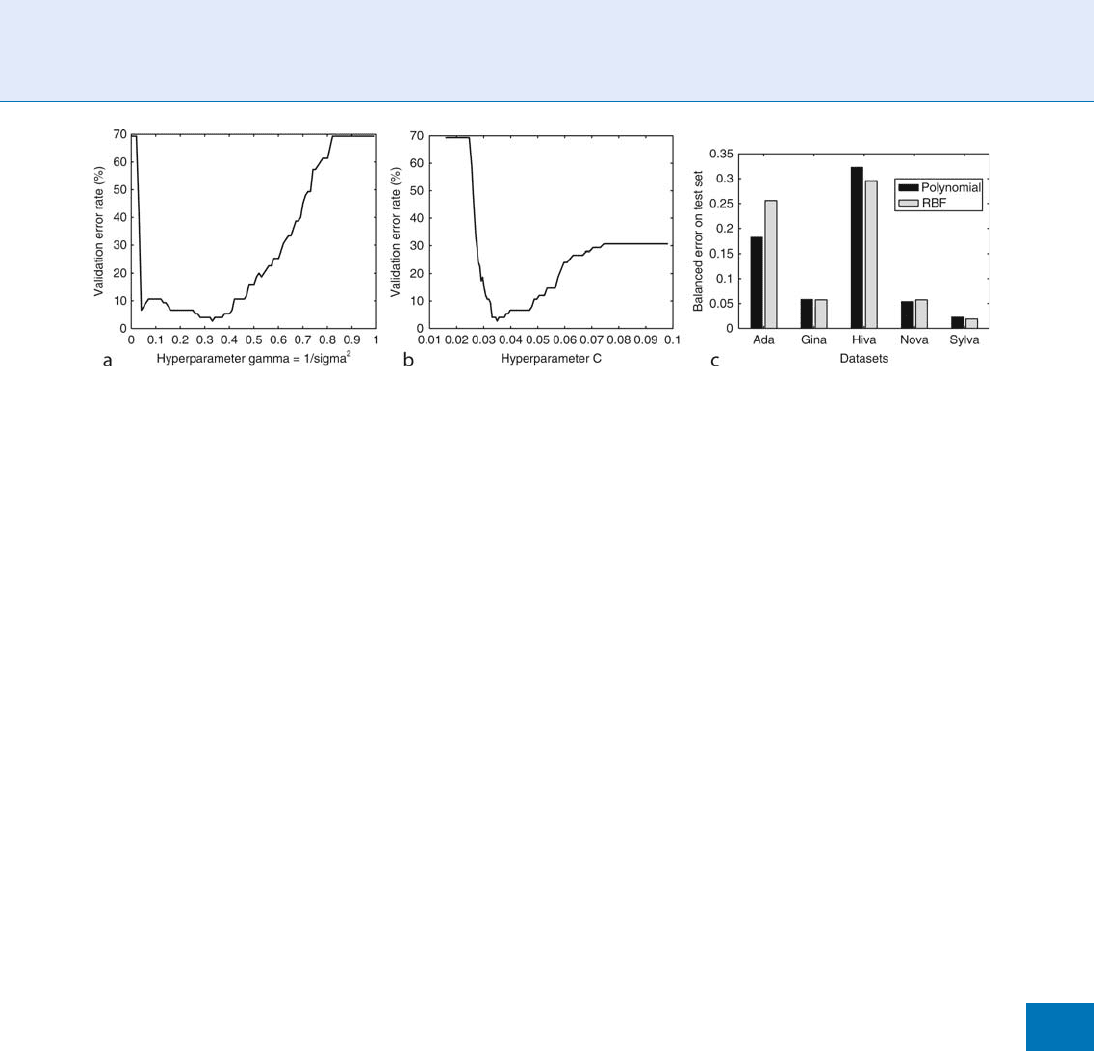
the polynomial kernel k(x
i
, x
j
)¼(ax
i
0
x
j
þ b)
d
with
parameters a, b and d. The task of selecting the hyper-
parameters that yield the best performance of the ma-
chine is called model selection [6 , 7, 8, 9].
As an illustra tion, Fig. 4a shows the variation of
the error rate on a validation set versus the variation
of the Gaussian kernel with a fixed value of C and
Fig. 4b shows the variation of the error rate on the
validation set versus the variation of the hyperpara-
meter C with a fixed value of the RBF kernel parameter.
In each case, the binary problem described by the
‘‘Thyroid’’ data taken from the UCI benchmark is
resolved. Clearly, the best performance is achieved with
an optimum choice of the kernel parameter and of C.
With the SVM, as with other kernel classifiers, the
choice of kernel corresponds to choosing a function
space for learning. The kernel determines the function-
al form of all possible solutions. Thus, the choice of
kernel is very important in the construction of a good
machine. So, in order to obtain a good performance
from the SVM classifier, one first need to design
or choose a type of kernel, and then optimize the
SVM’s hyperparameters to improve the generalization
capacity of the classifier. Figure 4c illustrates the influ-
ence of the kernel choice, where the RBF and the
polynomial kernels are compared on datasets taken
from the challenge website on model selection and
prediction organized by Isabelle Guyon.
Resolution of Multiclass Problems with
the SVM
The SVM is formulated for the binary classification
problem. However, there are some techniques used to
combine several binary SVMs in order to build a sys-
tem for the multiclass problem (e.g., a 10-class digit
recognition problem). Two popular methods are pre-
sented here:
OneVersustheRest: The idea of one versus the rest
is to construct as many SVMs as there are classes,
where each SVM is traine d to separate one class from
the rest. Thus, for a c-class problem, c SVMs are built
and combined to perform multiclass classification
according to the maximal output. The ith SVM is
trained with all the examples in the ith class with
positive labels, and all the other examples with negative
examples. This is also known as the One-Against-All
method.
Pairwise(orOneAgainstOne): The idea of pair-
wise is to construct c(c1)2 SVMs for a c-class prob-
lem, each SVM being trained for every possible pair of
classes. A common way to make a decision with the
pairw ise method is by voting. A rule for discriminating
between every pair of classes is constructed, and the
class with the largest vote is selected.
SVM Variants
The least squares SVM (LS-SVM) is a variant of
the standard SVM, and constitutes the response
to the following question: How much can the SVM
formulation be simplified without losing any of its
advantages? Suykens and Vandewalle [10] proposed
the LS-SVM where the training algorithm solves a
convex problem like the SVM. In addition, the training
algorithm of the LS-SVM is simplified, since a linear
problem is resolved instead of a quadratic problem
in the SVM case.
Support Vector Machine. Figure 4 (a) and (b) show the impact of SVM hyperparameters on classifier generalization,
while (c) illustrates the influence of the choice of kernel function.
Support Vector Machine
S
1307
S
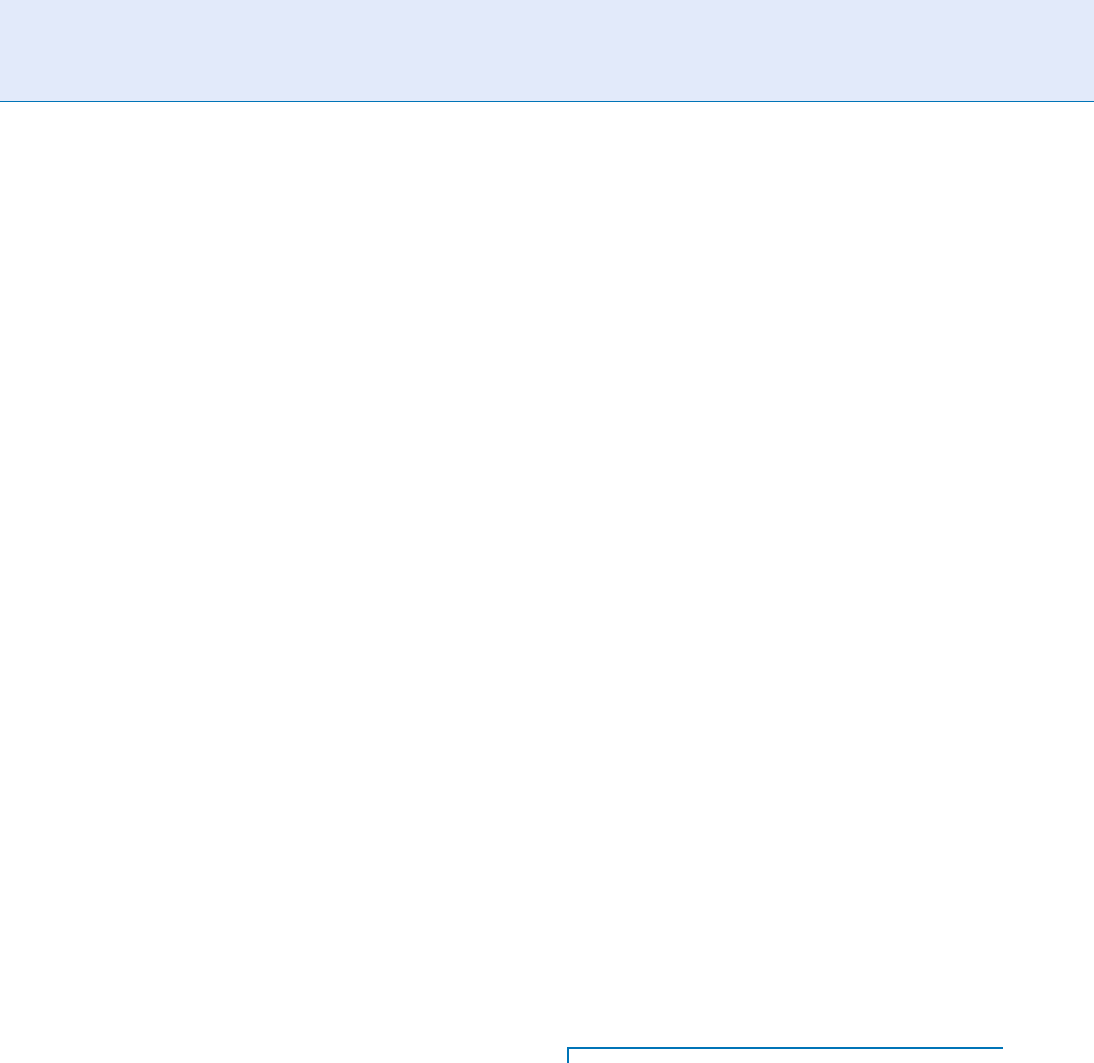
The Transductive SVM (TSVM) is an interesting
version of the SVM, which uses transductive inference.
In this case, the TSVM attempts to find the hyperplane
and the labels of the test data that maximize the
margin with minimum error. Thus, the label of the
test data is obtained in one step. Vapnik [1] proposed
this formulation to reinforce the classifier on the test
set by adding the minimization of the error on the
test set during the training process. This formula-
tion has been used elsewhere recently for training
semi-supervised SVMs.
Applications
The SVM is a powerful classifier which has been used
successfully in many pattern recognition problems,
and it has also been shown to perform well in
biometrics recognition applications. For example, in
[11], an iris recognition system for human identifica-
tion has been proposed, in which the extracted iris
features are fed into an SVM for classification. The
experimental results show that the performance of
the SVM as a classifier is far better than the perfor-
mance of a classifier based on the artificial neural
network. In another example, Yao et al. [12], in a
fingerprint classification application, used recursive
neural networks to extract a set of distributed features
of the fingerprint which can be integrated into the
SVM. Many other SVM applications, like handwriting
recognition [8, 13], can be found at www.clopinet.
com/isabelle/Projects/SVM/applist.html.
Related Entries
▶ Classifier
▶ Generalization
▶ Structural Risk
▶ Training
References
1. Vapnik, V.N.: Statistical learning theory. Wiley, New York (1998)
2. Boser, B.M.E., Guyon, I., Vapnik, V.: A training algorithm for
optimal margin classifiers. In: Proceedings of Fifth Annual
Workshop on Computational Learing Theory, pp. 144–152
(1992)
3. Scholkopf, B., Smola, A.J.: Learning with Kernels. MIT Press,
Cambridge, MA (2002)
4. Cristianini, N., Shawe-Taylor, J.: An Introduction to Support
Vector Machines. Cambridge Universit y Press (2000)
5. Joachims, T.: Making large-scale support vector machine
learning practical. In: Scholkopf, Burges, Smola (eds.) Advances
in Kernel Methods: Support Vector Machines. MIT Press,
Cambridge, MA (1998)
6. Chapelle, O., Vapnik, V.: Model selection for support vector
machines. Advances in Neural Information Processing Systems
(1999)
7. Ayat, N.E., Cheriet, M., Suen, C.Y.: Automatic Model Selection
for the Optimization of the SVM kernels. Pattern Recognit.
38(10), 1733–1745 (2005)
8. Adankon, M.M., Cheriet, M.: Optimizing Resources in Model
Selection for Support Vector Machines. Pattern Recognit. 40(3),
953–963 (2007)
9. Adankon, M.M., Cheriet, M.: New formulation of svm
for model selection. In: IEEE International Joint Conference
in Neural Networks 2006, pp. 3566–3573. Vancouver, BC
(2006)
10. Suykens, J.A.K., Van Gestel, T., De Brabanter, J., De Moor, B.,
Vandewalle, J.: Least Squares Support Vector Machines. World
Scientific, Singapore (2002)
11. Roy, K., Bhattacharya, P.: Iris recognition using support vector
machine. In: APR International Conference on Biometric
Authentication (ICBA), Hong Kong, January 2006. Springer
Lecture Note Series in Computer Science (LNCS), pp. (3882)
486–492 (2006)
12. Yao, Y., Marcialis, G.L., Pontil, M., Frasconi, P., Rolib, F.:
Combining flat and structured representations for fingerprint
classification with recursive neural networks and support vector
machines. Pattern Recognit. 36(2), 397–406 (2003)
13. Matic, N., Guyon, I., Denker, J., Vapnik, V.: Writer adaptation
for on-line handwritten character recognition. In: IEEE
Second International Conference on Pattern Recognition and
Document Analysis, pp. 187–191. Tsukuba, Japan (1993)
Surface Curvature
Measurements of the curvature of a surface are com-
monly used in 3D biometrics. The normal curvature on
a point p on the surface is defined as the curvature of
the curve that is formed by the intersection of the
surface w ith the plane containing the normal vector
and one of the tangent vectors at p. Thus the normal
curvature is a function of the tangent vector direction.
The minimum and maximum values of this function
are the principal curvatures k1 and k2 of the surface
1308
S
Surface Curvature
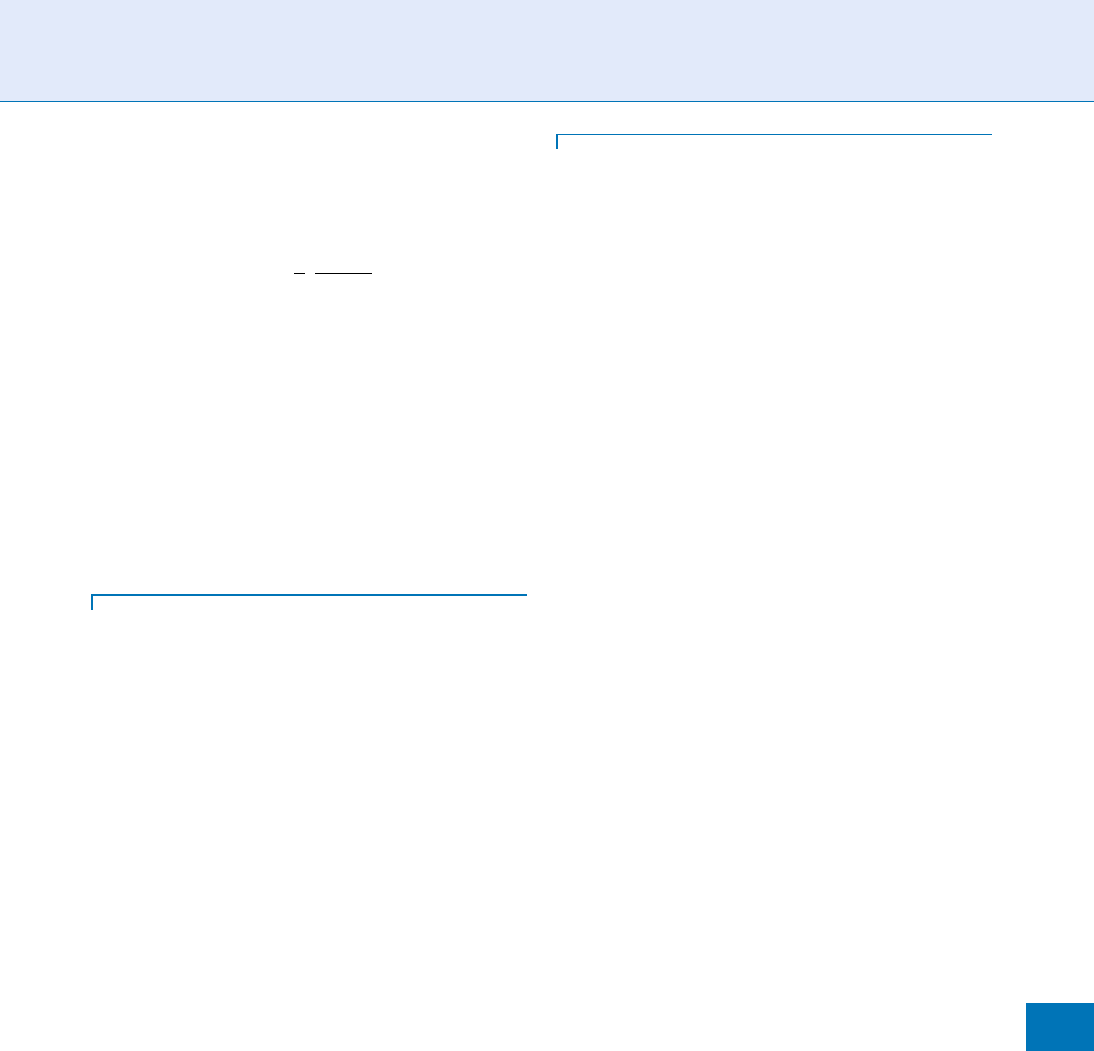
at p. Other measures of surface curvature are the
Gaussian curvature defined as the product of principal
curvatures, the mean curvature defined as the average
of principal curvatures and the shape index given by
SI ¼
2
p
k
2
þ k
1
k
2
k
1
Computation of surface curvature on discrete surfaces
such as those captured with 3D scanners is usually
accomplished by locally fitting low order surface
patches (e.g. biquadratic surfaces, splines) over each
point. Then the above curvature features may be com-
puted analytically.
▶ Finger Geometry, 3D
Surface Matching
3D biometrics work by computing the similarity be-
tween 3D surfaces of objects belonging to the same
class. The majority of the techniques used measure
the similarit y among homologous salient geometric
features on the surfaces (e.g. based on curvature).
The localization of these features is usually based on
prior knowledge of the surface class (e.g. face, hand)
and thus, specialized feature detectors may be used.
The geometric attributes extracted are selected so that
they are invariant to transformations such as rotation,
translation and scaling. In the case that knowledge-
based feature detection is difficult, a correspondence
among the surfaces may be established by randomly
selecting points on the two surfaces and then trying to
find pairs of points with similar geometric attributes.
Several such techniques have been developed for rigid
surface matching (e.g. Spin Images) which may be
extended for matc hing non-rigid or articulated sur-
faces. Another techn ique for establishing correspon-
dences is fitting a param eterized deformable model to
the points of each surface. Since the fitted models are
deformations of the same surface, correspondence is
automatically determined. Creation of such deform-
able models requires however a large number of anno-
tated training data.
▶ Finger Geometry, 3D
Surveillance
RAMA CHELLAPPA,ASWIN C. SANKARANARAYANAN
University of Maryland, College Park, MD, USA
Synonyms
Monitoring; Surveillance
Definition
Surveillance refers to monitoring of a scene along
with analysis of behavior of the people and vehicles
for the purpose of maintaining security or keeping a
watch over an area. Typically, traditional surveillance
involves monitoring of a scene using one or more
close circuit television (CCTV) cameras with person-
nel watching and making decisions based on video
feeds obtained from the
▶ cameras. There is a grow-
ing need towards building systems that are com-
pletely automated or operate with minimal human
supervision.
Biometric acquisition and processing is by far the
most important component of any automated surveil-
lance system. There are many challenges and variates that
show up in acquisition of biometrics for robust verifica-
tion. Further, in surveillance, behavioral biometrics is
also of potential use in many scenarios. Using the pat-
terns observed in a scene (such as faces, speech, behav-
ior), the system decides on a set of actions to perform.
These actions could involve access control (allowing/
denying access to facilities), alerting the presence of
intruders/abandoned luggage and a host of other secu-
rity related tasks.
Introduction
Surveillance refers to monitoring a scene using sensors
for the purposes of enhanced security. Surveillance
systems are becoming ubiquitous , especially in urban
areas with growing deployment of cameras and CCTV
for providing security in public areas such as banks,
shopping malls, etc. It is estimated that UK alone
has more than four million CCTV cameras. Surveil-
lance technologies are also becoming common for
Surveillance
S
1309
S
